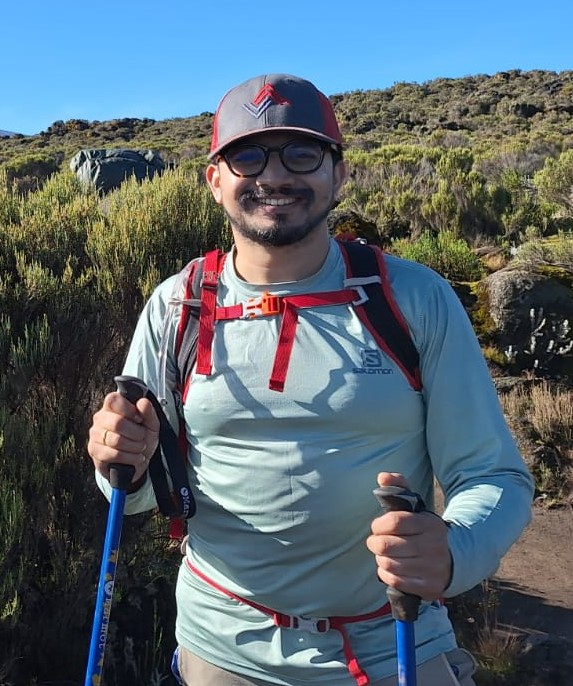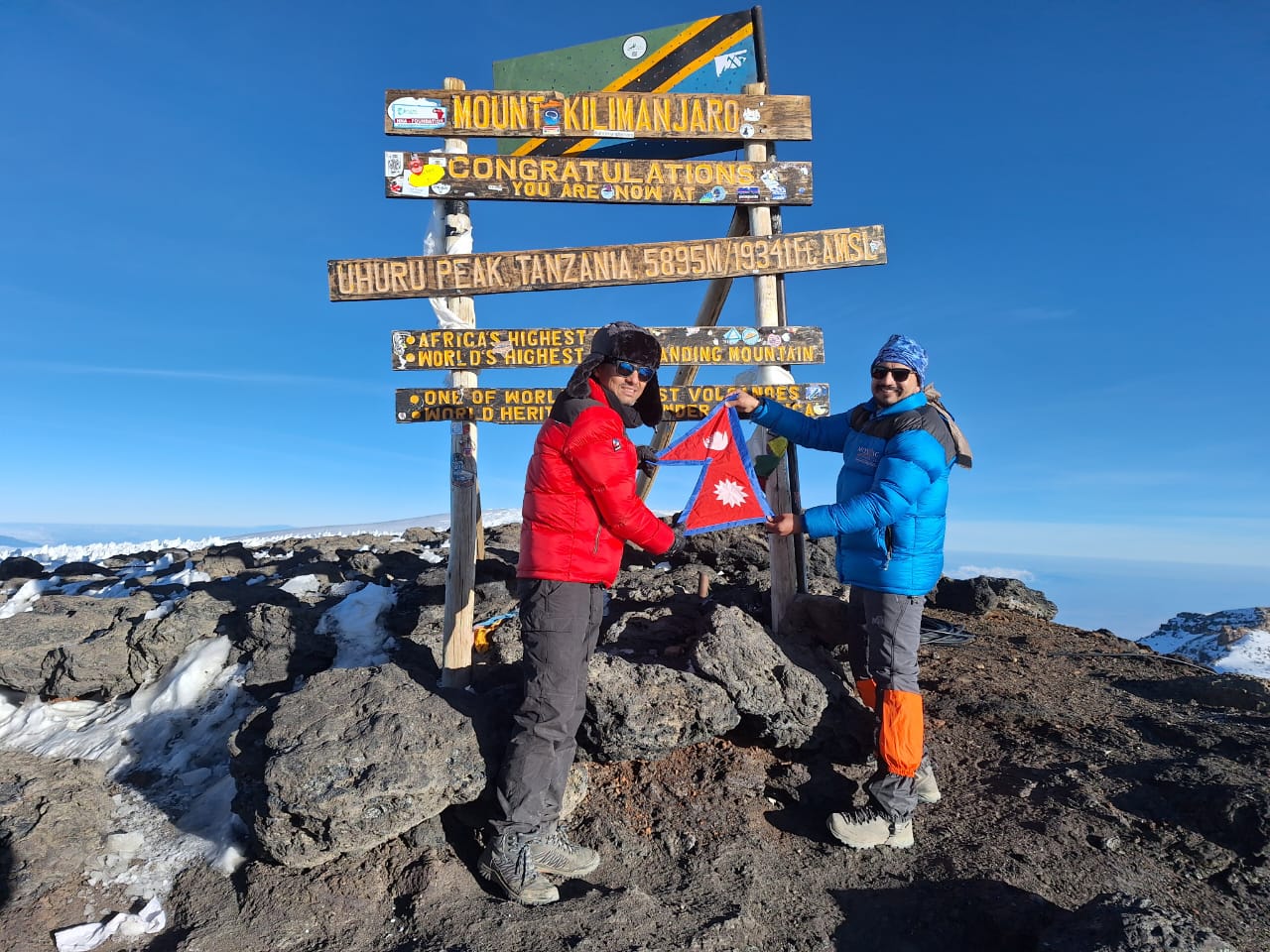
Back in our early 30s, my friend Biswo Khadka and I had a big dream to climb Kilimanjaro when we turned forty. I work in the adventure tour operating industry. Personally, hearing about our client’s experiences with Kilimanjaro, who come to Nepal for treks like Everest Base Camp, Manaslu Circuit, Annapurna Circuit, etc, further fueled my desire to experience it myself.
Last year, Biswo reminded me of our goal and we decided to embark on this adventure in June 2024. We scheduled our trip to Tanzania from June 15 to 27 and booked our Kilimanjaro climb with Sirikwa Travel, a local agency.
I arrived at Kilimanjaro International Airport in Arusha on June 15 and was picked up by our tour operator’s driver, who took us to the Sai Salinero Hotel in Moshi. We spent four nights there before starting our climb.
Our expedition began on June 19 from Moshi town and concluded on June 26, returning to Moshi before flying out the next morning. Before the climb, we relaxed at the hotel and enjoyed a day hike to Materuni Waterfall and a local coffee-tasting tour, visiting the home of the Chaga tribal people, which was a delightful experience.
Preparation
For the climb, I prepared by trekking and doing day hikes, covering distances from 3 km to 20 km. I walked around all the peaks within a day’s reach around Kathmandu, including Shivapuri Peak, Phulchoki, Champadevi and Jamacho.
I also did a two-day trek from Nagarkot to Chisapani and then to Sundarijal. These hikes helped build my stamina and prepare my body for the rigours of Kilimanjaro.
Equipment and Gear
- Duffel bag: carried by a porter, about 15 kilos
- Day pack: I recommend a 35-litre pack, as my 25-litre pack was insufficient
- Good hiking shoes: Humto’s worked well for me
- Creek shoes: for wearing around the camp
- Pair of walking poles
- 3 pairs of woolen thick socks
- 4 pairs of regular daily socks
- Hand and toe warmers: essential for summit day, as temperatures dropped to -7 to -10 degrees Celsius
- Thermal shirts and trousers
- 2 pairs of regular hiking pants
- 1 pair of thick hiking pants with fleece lining
- 2 pairs of half-sleeved shirts
- 2 pairs of full-sleeved shirts
- 1 sweatshirt
- 1 beanie hat
- 1 buff
- 1 pair of thick gloves
- 1 pair of liner gloves
- 1 down jacket
- One sleeping bag rated for minus 15 degrees Celsius—this is the Mosaic Adventure jacket with its logo, which you can see in my picture on top of Uhuru Peak.1 fleece jacket
- 1 waterproof windcheater
- Snacks (energy bars, nuts, etc.)
- Sunscreen (factor 70)
- Medicine (Diamox, paracetamol, ibuprofen, etc.)
- Camelback: 1.5 liters
- Water bottle: 1.5 litres (some days require carrying 2.5 to 3 litres)
- Thermos flask: for warm water in the morning (funny incident – our camping crew broke one of their flasks and borrowed mine for two days ☺ -)
The Climb

We chose the Lemosho route for our eight-day trek from June 19 to 26. Our group consisted of eight climbers and 31 crew members, which seemed large but was necessary to carry all the food, tents and equipment, including chemical toilets, kitchen tents, staff tents, dining tents, chairs and tables. We received three meals a day, which were varied and delicious.
Our group included two Nepali, four Americans, one Chinese and one Irish climber. The friendship and shared experiences made the journey even more memorable.
Itinerary
- Day 1: Sai Salinero Hotel – Lemosho Gate (2385 m) – Big Tree Camp (2650 m), 2-hour drive and 3-hour trek.
- Day 2: Big Tree Camp (2650 m) – Shira Camp 1 (3610 m), 4-hour trek.
- Day 3: Shira Camp 1 (3610 m) – Shira Camp 2 (3850 m), 4-hour trek.
- Day 4: Shira Camp 2 (3850 m) – Lava Tower (4600 m) – Barranco Camp (3900 m), 8-hour trek.
- Day 5: Barranco Camp (3900 m) – Karanga Camp (3995 m), 4-hour trek.
- Day 6: Karanga Camp (3995 m) – Barafu Camp (4673 m), 3.5-hour trek.
- Day 7: Barafu Camp (4673 m) – Stella Point (5756 m) – Uhuru Peak (5895 m) – Millennium Camp (3825 m), 15-hour trek.
- Day 8: Millennium Camp (3825 m) – Mweka Gate (1630 m) – Hotel, 5-hour trek and 30-minute drive.
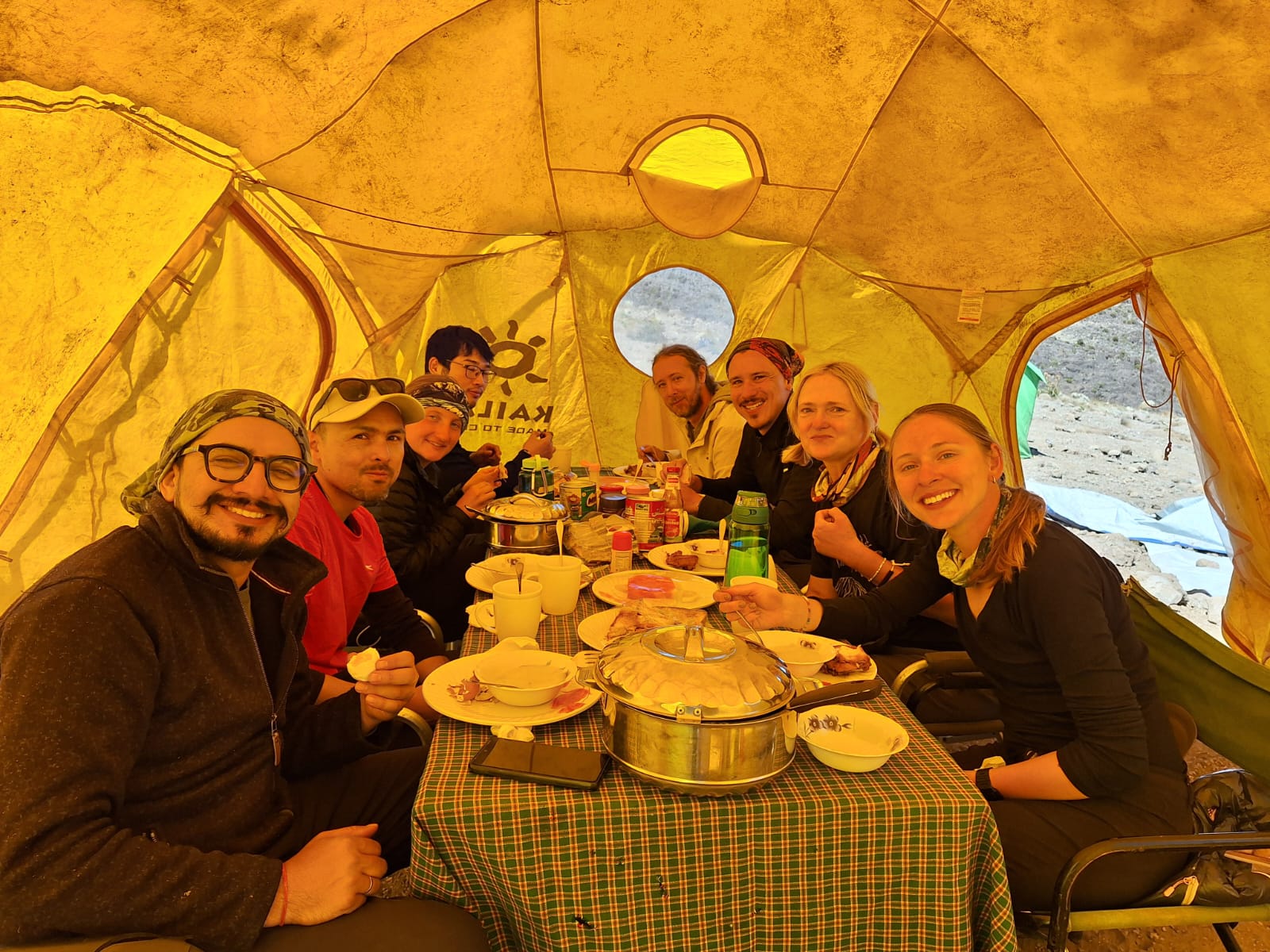
Highlights
The trek took us through diverse landscapes, from rainforests to alpine deserts. We spotted wildlife, including monkeys and birds and were fascinated by the unique flora, particularly the Giant Groundsels (Dendrosenecio). The views of Mount Kilimanjaro and Mount Meru were stunning, with clouds often seen below our camps.
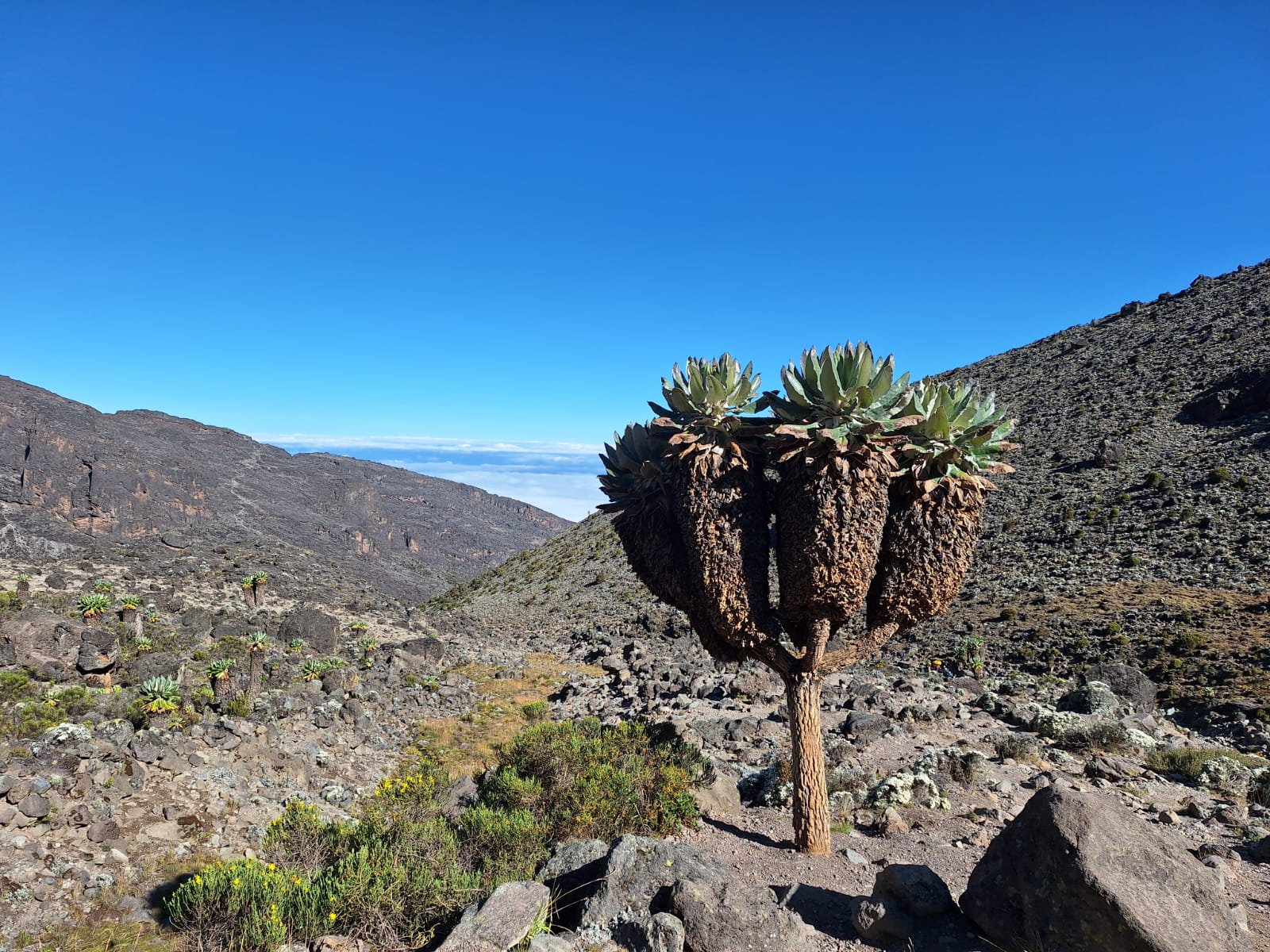
We encountered rain on two days, making the trail muddy and slippery. Unfortunately, my duffel bag wasn’t entirely waterproof and my sleeping bag and some clothes got wet. I recommend using a waterproof duffel bag and plastic covers to avoid this. Despite the rain, the remaining days were dry, allowing my gear to dry out.
The bonds formed with fellow climbers were special. We played cards, shared stories, and enjoyed laughter-filled evenings. Our guides—Geoffrey, Jonathan, Godslove and Lucina—and the cook, waiters, porters and toilet attendants, were exceptional.
Challenges
The physical and mental challenges were significant, especially on summit day. On June 24, we started our hike from Karanga Camp (3995 meters) to Barafu Camp (4673 meters), resting for a few hours before beginning our summit attempt at 11 pm. Climbing nearly 1900 meters in less than 24 hours was gruelling.
The summit attempt was slow and arduous. In Swahili, they say “Pole Pole,” meaning “slowly slowly.” Despite this, I experienced severe altitude sickness, vomiting multiple times and losing energy. After my second bout of vomiting, I handed the Nepal flag I intended to plant at the summit to Biswo, thinking I wouldn’t make it.
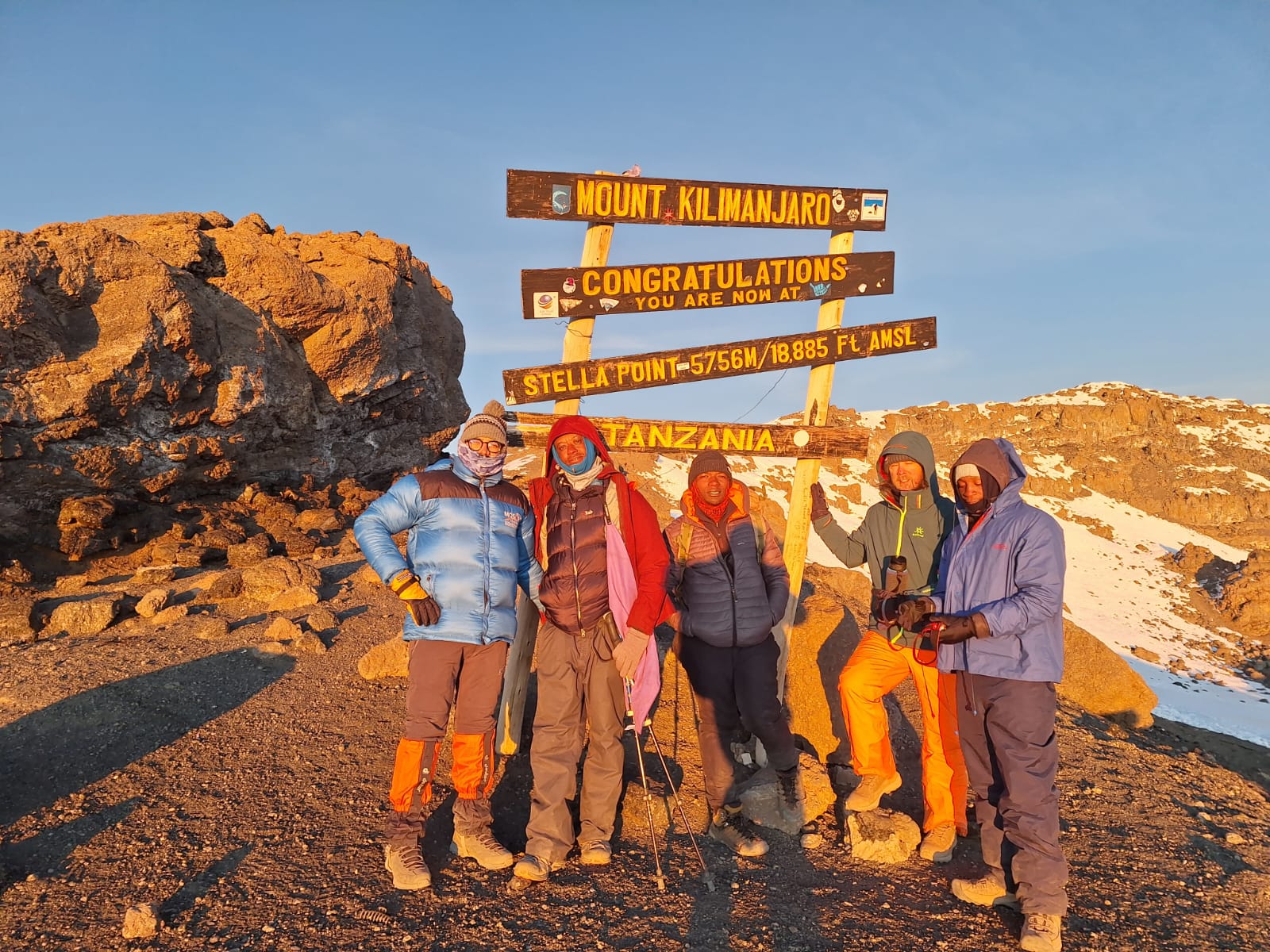
A humorous but challenging incident occurred when I had diarrhoea during the climb. I’m not fond of toilet paper and had asked Biswo to bring disposable wet wipes, which froze in the cold. Without proper supplies, I had to wait for it to dry—a unique challenge on the climb!
Jonathan, one of our guides, encouraged me to continue to Stella Point. Despite vomiting a third time and feeling utterly exhausted, I reached Stella Point (5756 meters) with his support. The emotions overwhelmed me, and I cried tears of joy. After some rest and ginger tea, I found the strength to push on to Uhuru Peak (5895 meters).
Reaching Uhuru Peak was an incredible moment. Biswo was shocked to see me and we embraced, crying tears of happiness. Our shared dream of summiting Kilimanjaro at forty had come true.
Among the eight climbers, I and another climber from Ireland struggled the most, but all of us made it to the top.
Summit Experience
Reaching the summit was a profound and emotional experience. The views from Uhuru Peak, the highest point in Africa, were breathtaking. The journey had pushed me to my limits and standing there, I felt an immense sense of accomplishment and gratitude. The friendship, the challenges and the triumphs made it a once-in-a-lifetime experience.
Climbing Kilimanjaro was a transformative experience. It taught me the power of perseverance, the importance of preparation and the joy of shared adventures. For those considering this climb, I recommend physical preparation through regular hikes, investing in quality gear and maintaining a positive mindset.
Practical Information
- Tips for future climbers: Prepare physically with regular hikes and fitness routines. Invest in good gear, especially waterproof items.
- Gear recommendations: Bring a 35-litre day pack, waterproof duffel bag and hand warmers.
- Guides and Tour Operators: Sirikwa Travel provided excellent support and organisation.
- Best Time of Year to Climb: June to October and December to February offer the best weather conditions for climbing.


